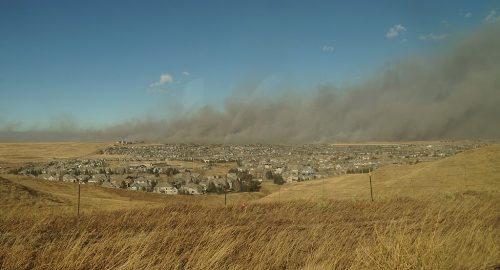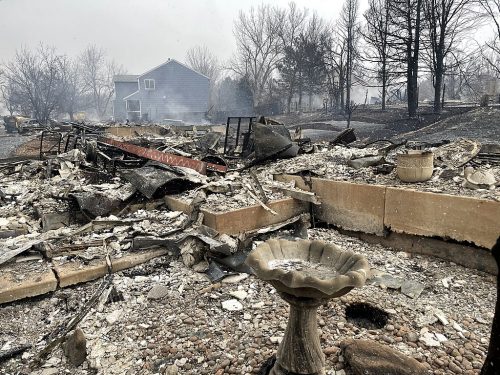Louisville, Colorado —(Map)
Two towns in Boulder County, Colorado are struggling to recover after terrible wildfires destroyed nearly 1,000 buildings. A snowstorm on Saturday put out the wildfires, but brought new problems as it dumped nearly 10 inches (25 centimeters) of snow in the area.
The Marshall wildfire is being called the most destructive wildfire to ever hit Colorado. Dry conditions and strong winds allowed the fire to spread extremely quickly. This gave people in the area very little time to get out of the path of the fire.
😕
This image has not been loaded because of your cookie choices. To view the content, you can accept 'Non-necessary' cookies.
Two towns in Boulder County, Colorado are struggling to recover after terrible wildfires destroyed nearly 1,000 buildings (above). The Marshall Wildfire is being called the most destructive wildfire to ever hit Colorado.
The Marshall fire and the Middle Fork fire began on Thursday morning as grass fires. It’s still not clear how the fires started, but they spread incredibly rapidly. That’s because the plants and trees in the area were extremely dry after a long drought. Strong winds blowing at speeds of up to 110 mph (175 kph) helped feed the flames and spread them further.
Unlike many wildfires, last week’s fires happened in places where many people live. The fires spread through towns located between the larger cities of Boulder and Denver. Over 30,000 people were forced to evacuate from Louisville, Superior, and two other nearby towns as the fire swept through the area.

(Source: Tristantech [CC BY-SA 4.0], via Wikimedia Commons.)
In less than eight hours, the blazes burned through 2.5 square miles (6.5 square kilometers). By Friday morning, the wildfires had burned roughly 9.7 square miles (25 square kilometers). The Middle Fork fire was brought under control on Friday, but the Marshall fire was harder to stop. Nearly 1,000 buildings were destroyed, including hundreds of homes, a hotel, and a shopping center.
Governor Jared Polis declared a state of emergency on Thursday. That allowed Mr. Polis to use more money to help out, and bring in the National Guard to help with rescue efforts. On Saturday, United States President Joe Biden declared a disaster, which will bring in even more money, and help the area recover.

(Source: Bmurphy380 [CC BY-SA 4.0], via Wikimedia Commons.)
In spite of the power of the wildfires, there have only been a few injuries. So far, no deaths have been reported, though three people are still missing.
Snow began falling on Friday night, helping to put out the fire. But by Saturday, the snow and falling temperatures had begun to cause new problems. Many homes in the area were left with no electricity and no gas for heating. With temperatures around 7º Fahrenheit (-14º Celsius), water pipes began freezing and breaking in many of the homes that had survived the blazes.
The snowstorm dumped about 10 inches (25 centimeters) of snow in the area. If it had fallen a few days earlier, the snow might have prevented the fires. Instead, it made rescue and recovery efforts harder.
😕
This image has not been loaded because of your cookie choices. To view the content, you can accept 'Non-necessary' cookies.
By Saturday, the snow and falling temperatures had begun to cause new problems. Many homes in the area were left with no electricity and no gas for heating. The snowstorm dumped about 10 inches (25 centimeters) of snow in the area.
Many people are looking at the part the climate crisis played in this disaster. Wildfire season used to run from May to November, but that’s no longer true. Jennifer Balch, who’s a fire scientist, told the Denver Post, “Climate change is definitely a part of this story, in that fire seasons are longer.”
Roughly 90% of Boulder County is suffering from a serious drought. This caused the dry conditions that allowed the flames to spread easily. Temperatures in the area have been unusually warm since July.
😕
This map has not been loaded because of your cookie choices. To view the content, you can accept 'Non-necessary' cookies.
